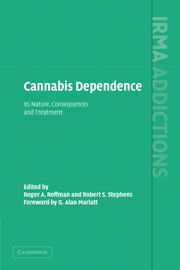Crossref Citations
This Book has been
cited by the following publications. This list is generated based on data provided by Crossref.
Hall, Wayne
and
Degenhardt, Louisa
2006.
What are the Policy Implications of the Evidence on Cannabis and Psychosis?.
The Canadian Journal of Psychiatry,
Vol. 51,
Issue. 9,
p.
566.
Greydanus, Donald E.
Calles Jr., Joseph L.
and
Patel, Dilip R.
2008.
Pediatric and Adolescent Psychopharmacology.
p.
241.
HALL, WAYNE
and
DEGENHARDT, LOUISA
2008.
Cannabis use and the risk of developing a psychotic disorder.
World Psychiatry,
Vol. 7,
Issue. 2,
p.
68.
HALL, WAYNE D.
2009.
Challenges in reducing cannabis‐related harm in Australia.
Drug and Alcohol Review,
Vol. 28,
Issue. 2,
p.
110.
Roffman, Roger
2010.
The Corsini Encyclopedia of Psychology.
p.
1.
Cascone, Pablo
Zimmermann, Grégoire
Auckenthaler, Bertrand
and
Robert-Tissot, Christiane
2011.
Cannabis Dependence in Swiss Adolescents.
Swiss Journal of Psychology,
Vol. 70,
Issue. 3,
p.
129.
Hall, Wayne
and
Degenhardt, Louisa
2011.
Marijuana and Madness.
p.
55.
Boden, Matthew Tyler
McKay, James R.
Long, W. Robert
and
Bonn‐Miller, Marcel O.
2013.
The effects of cannabis use expectancies on self‐initiated cannabis cessation.
Addiction,
Vol. 108,
Issue. 9,
p.
1649.
van Ours, Jan C.
and
Williams, Jenny
2014.
Cannabis Use and its Effects on Health, Education and Labor Market Success.
SSRN Electronic Journal,
Gates, Peter J.
Albertella, Lucy
and
Copeland, Jan
2014.
The effects of cannabinoid administration on sleep: a systematic review of human studies.
Sleep Medicine Reviews,
Vol. 18,
Issue. 6,
p.
477.
Babson, Kimberly A.
and
Bonn-Miller, Marcel O.
2014.
Sleep Disturbances: Implications for Cannabis Use, Cannabis Use Cessation, and Cannabis Use Treatment.
Current Addiction Reports,
Vol. 1,
Issue. 2,
p.
109.
Hall, Wayne
2015.
What has research over the past two decades revealed about the adverse health effects of recreational cannabis use?.
Addiction,
Vol. 110,
Issue. 1,
p.
19.
van Ours, Jan C.
and
Williams, Jenny
2015.
CANNABIS USE AND ITS EFFECTS ON HEALTH, EDUCATION AND LABOR MARKET SUCCESS.
Journal of Economic Surveys,
Vol. 29,
Issue. 5,
p.
993.
Darke, Shane
and
Farrell, Michael
2016.
Which medications are suitable for agonist drug maintenance?.
Addiction,
Vol. 111,
Issue. 5,
p.
767.
Bonn-Miller, Marcel O.
Heinz, Adrienne J.
Smith, Everett V.
Bruno, Raimondo
and
Adamson, Simon
2016.
Preliminary Development of a Brief Cannabis Use Disorder Screening Tool: The Cannabis Use Disorder Identification Test Short-Form.
Cannabis and Cannabinoid Research,
Vol. 1,
Issue. 1,
p.
252.
Drolen, Carol S.
2016.
First Impressions: Stopping by a Marijuana Shop.
Journal of Social Work Practice in the Addictions,
Vol. 16,
Issue. 4,
p.
448.
Soyka, M.
Preuss, U.
and
Hoch, E.
2017.
Cannabisinduzierte Störungen.
Der Nervenarzt,
Vol. 88,
Issue. 3,
p.
311.
Bhardwaj, Anjali K.
Allsop, David J.
Copeland, Jan
McGregor, Iain S.
Dunlop, Adrian
Shanahan, Marian
Bruno, Raimondo
Phung, Nghi
Montebello, Mark
Sadler, Craig
Gugusheff, Jessica
Jackson, Melissa
Luksza, Jennifer
and
Lintzeris, Nicholas
2018.
Randomised Controlled Trial (RCT) of cannabinoid replacement therapy (Nabiximols) for the management of treatment-resistant cannabis dependent patients: a study protocol.
BMC Psychiatry,
Vol. 18,
Issue. 1,
Graham, Veronica E.
and
Clough, Alan R.
2018.
Cannabis Use Among Remote Indigenous Australians: Opportunities to Support Change Identified in Two Waves of Sampling.
Frontiers in Public Health,
Vol. 6,
Issue. ,
Cavazos-Rehg, Patricia A.
Krauss, Melissa J.
Sowles, Shaina J.
Murphy, Gabrielle M.
and
Bierut, Laura J.
2018.
Exposure to and Content of Marijuana Product Reviews.
Prevention Science,
Vol. 19,
Issue. 2,
p.
127.



